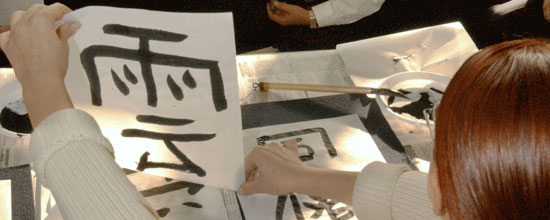North Korean Preschoolers Work Calligraphic Wonders
Chae Gook-beom, a five-year-old kid from a kindergarten in the Tonghung-dong district of Pyongyang was overwhelmed with medals, diplomas and other prizes for his extraordinary aptitude for wielding the brush that astounded local calligraphy masters. The jury board of a republican calligraphic contest were «deeply impressed», as local media report, by the boy’s work entitled «We Wish Good Health To Our Marshal.»
Calligraphic competitions are often held in North Korea featuring professional artists side by side with students, schoolchildren, and all persons interested. Preschoolers’ works usually receive no less attention than those of the recognized masters of the art of beautiful handwriting. According to local experts, the pupils of the Sinuiju kindergarten are the best of the best among the youngest brush masters.
Gu Da-seon is one of them: at the age of seven, he created a work of art that brought him nationwide fame. The child depicted the rang syllable from the phrase the Baekdu Horangee (the Baekdu Tiger), which left calligraphy connoisseurs awe-stricken. The syllable executed in Gu Da-seon’s style is the final part of the logotype of Arirang, the famous artistic and sporting performance listed in the Guinness World Records. Local masters refine their skills by writing well-known dicta and slogans such as: the Baekdu Mountain, the Sun of the Nation, Seongun (the «Military First» policy), the Cradle of Life, etc.
North Koreans can easily distinguish autographs and handwritings of the nation’s leaders. Their handwriting styles were largely adopted in contemporary North Korean calligraphy even acquiring poetic names of their own: Kim Il-sung’s hand is called the Style of the Sun, Kim Jong-il’s — the Style of the Holy Mount Baekdu, his mother’s (Kim Jong-suk) — the Style of the Sun Rays. Local masters define these styles as «innovative, unique, unprepossessing, and full of inner strength.»
From times immemorial, a beautiful hand was a mark of good education whereas the art of calligraphy — fluent, refined lettering — was highly esteemed by the wise. Recently, North Korean archaeologists have discovered the tomb of Han Seok-bong (1543-1606), a famous Korean calligrapher of the Li Dynasty, at the North Hwanghae Province. According to the Pyongyang Times, the tombstone bears an inscription establishing his identity and enumerating his high offices at the court due to his beautiful and distinct handwriting.
Many North Korean students spend hours in calligraphic exercises. They grind a black chunk of the mok dry ink in a stone mortar, add some water, and the heap of black powder transforms into Dragon Tear, the Korean poetic reference to ink.
 North Korean Preschoolers Work Calligraphic Wonders
North Korean Preschoolers Work Calligraphic WondersSource: tass-press.ru